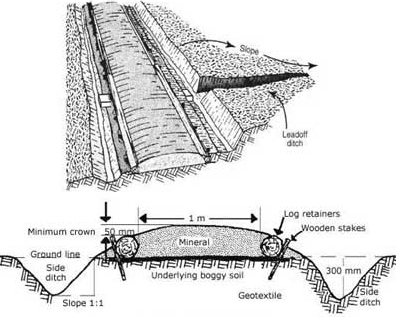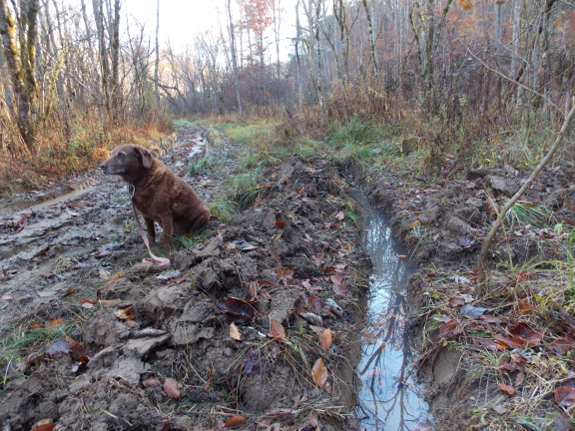
Building a road in wet soil
 I really appreciated everyone's feedback on my ditch experiment, especially the reader who sent me to this excellent webpage.
Apparently, mounding the dirt from the ditches up on top of the road is
the solution, a technique known as a turnpike. For best results,
we'll want to splurge on some geotextile fabric to go under the new dirt
--- the stuff at Lowes is expensive ($1/linear foot and up), but
probably worth it. Maybe that will be our next big expenditure
(plus renting heavy equipment to make the digging go easier) once chicken waterer season kicks in next year and we're feeling more flush.
I really appreciated everyone's feedback on my ditch experiment, especially the reader who sent me to this excellent webpage.
Apparently, mounding the dirt from the ditches up on top of the road is
the solution, a technique known as a turnpike. For best results,
we'll want to splurge on some geotextile fabric to go under the new dirt
--- the stuff at Lowes is expensive ($1/linear foot and up), but
probably worth it. Maybe that will be our next big expenditure
(plus renting heavy equipment to make the digging go easier) once chicken waterer season kicks in next year and we're feeling more flush.

In the meantime, I
thought you might like to see the results of our hand-dug
experiment. Wednesday night's rain raised the groundwater level by
six or seven inches, so it was easy to see what was going on in our
little ditches. They definitely filled up, but they don't seem to
be moving the water away from the road so much as collecting it in
place.
I suspect that we need to commit to making the perpendicular ditch slope
all the way down to the alligator swamp (the old bed of Sinking Creek)
if we want the ditches to be effective in draining moisture away from
the road. If we feel really industrious this winter, we may dig
that side ditch out by hand, but it's brutal digging in the swamp --- so
much easier to forget about the problem and hope it goes away....
Want more in-depth information? Browse through our books.
Or explore more posts by date or by subject.
About us: Anna Hess and Mark Hamilton spent over a decade living self-sufficiently in the mountains of Virginia before moving north to start over from scratch in the foothills of Ohio. They've experimented with permaculture, no-till gardening, trailersteading, home-based microbusinesses and much more, writing about their adventures in both blogs and books.
Want to be notified when new comments are posted on this page? Click on the RSS button after you add a comment to subscribe to the comment feed, or simply check the box beside "email replies to me" while writing your comment.

I think that pieces of thick rugs would work as a separator between roadbase and the muck underneath. I have had to remove a large piece of buried rug before and the stuff ties the soil above pretty good. just a thought. you could go to town and look for a large roll of discarded rug (maybe near apartment complexes, etc) and test it on a section of your road. it would be cheap experiment to see if you could replace that fabric with a reclaimed material.
also, two years ago I bought a roll of weed barrier from Sam's club. this year I dug in the area by accident and to my surprise the barrier was intact down there. maybe that material laid down in 3 or 4 layers could do as well...
Yes. Without a gradient, water won't go anywhere... You don't need much though. A large river can do fine with a gradient of 5 in/mile. The smaller the channel, the bigger the gradient that you'll need. This is because smaller channels have more hydraulic resistance at a given speed.
Generally, rugs from natural materials will rot away. Rugs made from artificial fibers have a good chance of containing fire retardants. Now those could be relatively harmless stuff like ammonium polyphosphate or aluminum hydroxide. But it could also be nasty chlorine or bromine compounds.